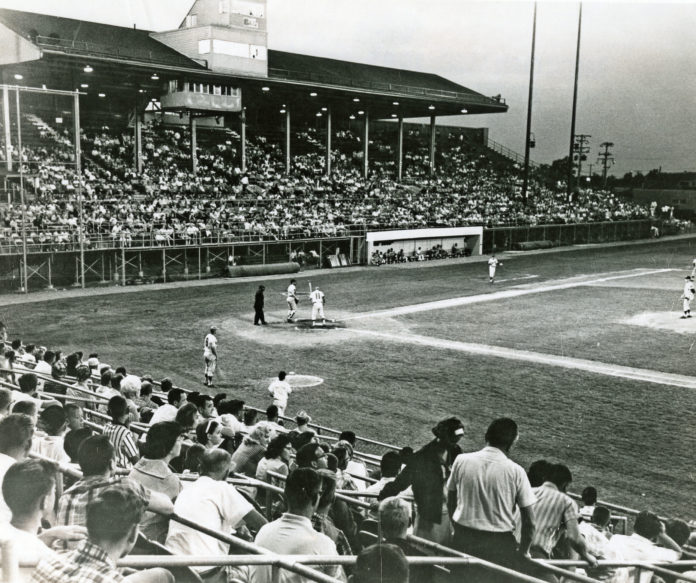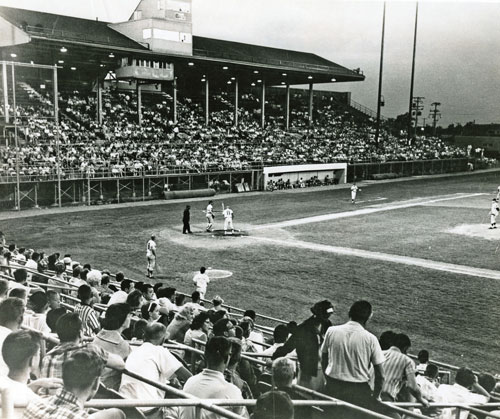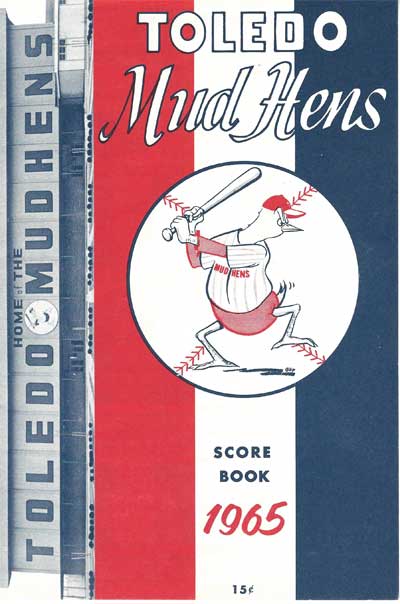
This year marks the 50th anniversary of the current Mud Hens franchise, but like a Mike Hessman home run sent beyond the stretches of center field, Toledo’s baseball history runs much farther and deeper than that.
Though it may seem hard to believe, it wasn’t always the Mud Hens highlighting our summers in Toledo; the team has played under different names, and in different stadiums, leagues and affiliations — spanning back as far as 1883.

In 1955, our hometown boys of summer were taken from Northwest Ohio following a sudden franchise move to Wichita, Kansas, by parent club Milwaukee Braves’ owner Lou Perini. The move deprived local fans of baseball for nine long years. It took a local hero named Edward J. “Ned” Skeldon to bring back the game in 1965.
Losing baseball twice
“Everybody was just floored they left [in 1955],” said John Husman, Mud Hens team historian, who was 13 years old at that time. “I went to most games, and when that happened I was angry. I remember being angry at Lou Perini. I can remember that emotion. A lot of other people were disappointed. [Baseball] was a big part of my life.”
Toledo had actually lost another team just three years prior. In June 1952, then-Hens owner Danny Menendez moved the team to Charleston, West Virginia. The move was met with opposition, and despite still being called the Toledo Mud Hens, the team played its remaining home games in Charleston that season and never came back.
RELATED: Mud Hens go retro with quirky promotions
RELATED: Downtown businesses step up to plate for Opening Day
Read more Mud Hens Opening Day coverage here:
The next spring, the major league’s Boston Braves moved to Milwaukee, displacing the minor league Brewers and sending that franchise to Toledo — this time reincarnated as the Sox.
“It was a huge success,” Husman said. “They won the pennant.”
Even with an entertaining team and decent attendance, the Sox left after the 1955 season, which sent Skeldon — then Toledo’s vice mayor — into action. Skeldon was not only seeking a new team, but also a new stadium, because venerable Swayne Field, built in 1909, was demolished in 1956 to make way for a new Kroger store.
Baseball fans can still view a piece of history from that era: A portion of the original Swayne Field outfield remains at the corner of Monroe Street and Detroit Avenue to this day; that wall was baseball’s first-ever concrete outfield fence in the nation (see photograph on page 27).
Chuck Bracken has officially served on the Hens board since 1978, although he remembers attending board meetings as early as ’65 or ’66 as the lone representative from the Hens’ accounting firm, Arthur Young & Company. He, too, was disappointed when the Hens left town in 1955.
“For those of us who like baseball, like anything else, it deprived us of our candy,” Bracken said. “We had nowhere else to go in the evenings. I loved baseball. When the Mud Hens left the first time, it was different, and when the Sox came in there was a lot of enthusiasm, but not enough to pay the bills.”
Bringing baseball back
Once the Sox were gone, Skeldon stepped in.
He began immediately dealing with a lot of the bureaucratic details one might expect in building a new franchise from the ground up: determining who would own the club, where the team would play and with what major league club it would be affiliated.
A nine-year baseball absence might seem like a long time to fans, but Skeldon bringing it all together in that time, through governmental agencies, no less, was no small task.
What’s more, minor league teams had a reputation back then of being hard to keep in the black.
Bracken recalls fearing some of the backlash team officials might potentially face in the press: Should the county be involved with building such a massive recreation center? Why should it be involved with professional sports in the first place? Why situate the team in a suburb, and not Toledo?
“It was a county project, so like all political projects, you get a lot of people who were opposed to it,” Bracken said. “That was the atmosphere of the time. Ned Skeldon, who in my mind was the director of this, was saying that there could be a lot of negativity by the county providing [the Hens] a place to play.”
The 1965 return
Skeldon persisted through it all.
As president of the Lucas County Commissioners in 1963, he successfully led a campaign to turn the Lucas County Fairgrounds into a recreation center, and convert an old horse racetrack and one time-football stadium into a minor league ballpark.

A score book from 1965, the year the Mud Hens returned to Toledo after a nine-year absence. Photo Courtesy Toledo Mud Hens
Skeldon, along with Henry Morse and Steve Stranahan, among others, then negotiated a plan with Richmond Virginians owner Romeo Champagne to purchase his International League team for $75,000.
At long last, the Hens would return for good beginning with the 1965 season, although Bracken recalls little of the fanfare one might expect today.
“There was the usual opening day ceremony, and it was a little bit different because it was the first time we played baseball in town in years, but I don’t remember anything particularly special about it,” he said.
Over 5,000 fans attended the inaugural game at the new stadium, which then seated 8,000 and eventually held over 10,000 for much of its tenure.
One of Skeldon’s five children followed in his professional footsteps. Although current Lucas County Commissioner Tina Skeldon Wozniak was just a young girl at the time, she was thrilled to see baseball back in Toledo in 1965 because that meant spending time with her dad.
“I just remember having a ball — I had a great time,” Skeldon Wozniak said. “We got to go to the rec center and go to games with our dad. We met every coach, and would meet all their kids.
“Our summertime was spent — after playing in the neighborhood —going to games. I think I was one of the luckiest children, and we all had those fond memories.”
The ballpark would eventually be named in Skeldon’s honor in 1988, although he died just three months after the dedication. Today, “The Ned” remains in active use with rec leagues and high school sports.
“He was a role model for me, and a role model for a lot of people, who cared about everyone very much,” Skeldon Wozniak said. “He was also a super nice guy.”
Hens here to stay
The Hens are often mistakenly noted county-owned. Rather, the franchise is officially owned by its own board of trustees and set up as a not-for-profit corporation, with Lucas County as the ultimate beneficiary — all arranged in a way that the team can never be sold, Bracken said.
In short, the Hens are here to stay for good.
“I think Toledo is a baseball town, and behaves like one,” Skeldon Wozniak said. “I’d say baseball, under this regime and leadership, they’ve made baseball even better than it was. It started with [former GM] Gene Cook and turned it over to Joe Napoli. They know how to run a baseball team, and make it a place where people want to go.”
Looking back at 50 years of the franchise, most tend to agree that it has never been stronger.
“I continue to be amazed at attendance,” Bracken said. “When we put those Mud Hens together [in 1965], we anticipated roughly 400,000 would attend that first year, and figured that it would fall off after the honeymoon period. In 2002 (Fifth Third Field’s inaugural year), we had 550,000, and in every year since then. So, that means the population is still supporting us with as much enthusiasm as they had in the 1970s, so I’m really surprised.”
The team plans no formal recognition of its 50th anniversary this year, according to Mike Keedy, Toledo Mud Hens manager of special events, as it prefers to focus on the long tradition and overall common thread of all Toledo baseball history.
Opening Day is April 16, featuring a doubleheader of two seven-inning games starting at 4 p.m. The Hens are also offering an Opening Day Bash and an Opening Day Beer Bash 3-5 p.m. Visit www.mudhens.com for more information.






















